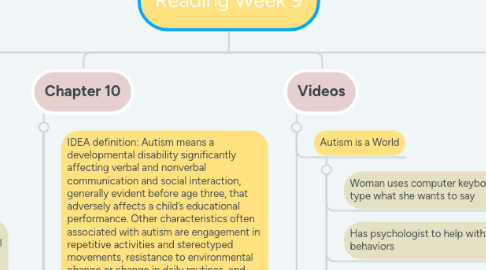
1. Chapter 4
1.1. Collaboration
1.2. o Means more than working together and is not a synonym for inclusion
1.3. o The definition is “a style for direct interaction between at least two co-equal parties voluntarily engaged in shared decision making as they work toward a common goal”
1.4. o Refers to how you interact with others, not what you are doing
1.5. o Choice of whether you and your colleagues use the style of collaboration remains voluntary
1.6. o It is based on parity
1.7. o Requires a mutual goal
1.8. o Involves shared responsibility for key decisions
1.9. o Includes shared accountability for outcomes
1.10. o Requires sharing resources
1.11. o It is emergent
1.12. Parity
1.13. o Collaboration concept that participants’ contributions are equally valued whether those contributions are great or small
1.14. o Work to ensure parity in interactions with both parents and general education colleagues as well as paraprofessionals and others
1.15. Shared accountability
1.16. o Collaboration concept in which participants jointly accept the outcomes of their decisions, positive or negative
1.17. List and summarize the effective communication strategies as explained in the text.
1.18. o Want to listen
1.19. o Demonstrate listening behavior
1.20. o React positively
1.21. o Emphasize with the other person
1.22. o Ask questions
1.23. o Leave your emotions behind (if you can)
1.24. o Get rid of distractions
1.25. o Get the main points
1.26. o React to ideas, not to the person
1.27. o Do not argue mentally
1.28. o Use the difference in rate
2. Chapter 10
2.1. IDEA definition: Autism means a developmental disability significantly affecting verbal and nonverbal communication and social interaction, generally evident before age three, that adversely affects a child’s educational performance. Other characteristics often associated with autism are engagement in repetitive activities and stereotyped movements, resistance to environmental change or change in daily routines, and unusual responses to sensory experiences.
2.2. What environmental supports can be used to aid students with autism?
2.3. o Visual supports such as
2.4. A visual schedule
2.5. Tasks cards
2.6. Travel card
2.7. o Assistive Technology
2.8. o Instructional Practices such as
2.9. Priming
2.10. Discrete trial interventions
2.11. Prompting
2.12. Social skills support
2.13. Instruction
2.14. Social stories
2.15. SOCCSS
3. Videos
3.1. Autism is a World
3.1.1. Woman uses computer keyboard to type what she wants to say
3.1.2. Has psychologist to help with her behaviors
3.1.3. Wear helmet when impulses to bang head were strong
3.1.4. Needs a person to be with her through all activities 24 hours
3.1.5. Loves learning but is hard to sit quietly
3.1.6. Likes to watch water – says she zones out
3.2. Saving Brains, a Grand Challenge
3.2.1. Your brain physically and functionally changes with your experiences
3.2.2. Supplying a few key elements at the beginning of a kid’s life reaps massive rewards
3.2.3. To enrich a child’s brain, provide a platform of health and nutrition and create a stronger focus on play-based responsive stimulation
3.2.4. Make early investments in nutrition
3.3. Abuse and Neglect
3.3.1. Consequences of abused children are 25% more likely to be engaged in activities that result in teen pregnancy and other sexual problems
3.3.2. Responsibility as a teacher or child-care worker is to report first-hand information
3.3.3. Must continue to collaborate with CPS
4. More Videos
4.1. Whitney Elementary
4.1.1. Families with many backgrounds and tragedies
4.1.2. School provides food, help with medical care, clothing, and other necessities that families cannot afford
4.1.3. Organization that helps with birthday parties
4.1.4. Everything is by volunteer and donation to help children in need at the school
4.2. ALL means ALL
4.2.1. Multi-tiered system of support helps increase academic engagement for all students
4.2.2. ALL students can participate within general education curriculum
4.3. SWIFT Domains and Features
4.3.1. Goal is to bring the expertise into the classrooms, teaching kids all together, and have the most highly qualified people working with students
4.3.2. Noticed becoming stronger instructors by including students with disabilities
4.3.3. Strive for consistency in practice
